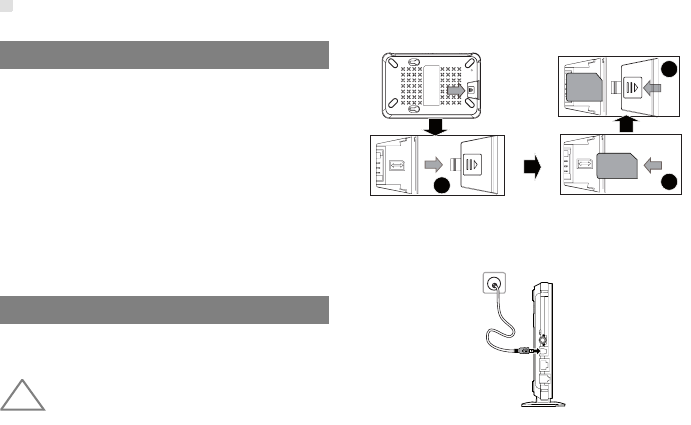Huawei Technologies B200-40 Wireless Gateway User Manual User Guide
Huawei Technologies Co.,Ltd Wireless Gateway User Guide
Contents
- 1. User Manual Part 1
- 2. User Manual Part 2
User Manual Part 1

Notice
Copyright © Huawei Technologies Co., Ltd. 2009.
All rights reserved.
1No part of this document may be reproduced or transmitted in
any form or by any means without prior written consent of
Huawei Technologies Co., Ltd.
2The product described in this manual may include copyrighted
software of Huawei Technologies Co., Ltd and possible licen-
sors. Customers shall not in any manner reproduce, distribute,
modify, decompile, disassemble, decrypt, extract, reverse
engineer, lease, assign, or sublicense the said software,
unless such restrictions are prohibited by applicable laws or
such actions are approved by respective copyright holders
under licenses.
3
Trademarks and Permissions
4 HUAWEI, and are trademarks or registered
trademarks of Huawei Technologies Co., Ltd.
5Other trademarks, product, service and company names
mentioned are the property of their respective owners.
6
Notice
7Some features of the product and its accessories described
herein rely on the software installed, capacities and settings of
local network, and may not be activated or may be limited by
local network operators or network service providers, thus the
descriptions herein may not exactly match the product or its
accessories you purchase.
8Huawei Technologies Co., Ltd reserves the right to change or
modify any information or specifications contained in this man-
ual without prior notice or obligation.
9
NO WARRANTY
10 THE CONTENTS OF THIS MANUAL ARE PROVIDED “AS
IS”. EXCEPT AS REQUIRED BY APPLICABLE LAWS, NO
WARRANTIES OF ANY KIND, EITHER EXPRESS OR
IMPLIED, INCLUDING BUT NOT LIMITED TO, THE IMPLIED
WARRANTIES OF MERCHANTABILITY AND FITNESS FOR
A PARTICULAR PURPOSE, ARE MADE IN RELATION TO
THE ACCURACY, RELIABILITY OR CONTENTS OF THIS
MANUAL.
11 TO THE MAXIMUM EXTENT PERMITTED BY APPLICABLE
LAW, IN NO CASE SHALL HUAWEI TECHNOLOGIES CO.,
LTD BE LIABLE FOR ANY SPECIAL, INCIDENTAL, INDI-
RECT, OR CONSEQUENTIAL DAMAGES, OR LOST PROF-
ITS, BUSINESS, REVENUE, DATA, GOODWILL OR
ANTICIPATED SAVINGS.
Import and Export Regulations
12 Customers shall comply with all applicable export or import
laws and regulations and will obtain all necessary governmen-
tal permits and licenses in order to export, re-export or import
the product mentioned in this manual including the software
and technical data therein.

Quick Start 1
Appearance ............................................... 1
PC Configuration Requirements ................2
Installation ................................................. 2
Making a Call .............................................4
Dial-up Access ..........................................4
Restoring the Factory Defaults ..................5
Using the Management Page 6
Management Page Overview ....................6
Viewing Configuration Info ........................6
Quick Setup ...............................................7
Configuring Your Computer 10
Wireless Configuration ............................10
Configuring the PC Network ....................11
Advanced Settings 12
Overview .................................................12
System Management .............................. 12
SIM Settings .............................................13
Mobile Network Settings ..........................14
Dial-up Settings .......................................15
DHCP Settings ....................................... 16
Clip Settings ............................................ 17
WLAN Settings ........................................17
Security Settings 21
Firewall Switch ........................................21
LAN MAC Filter .......................................21
LAN IP Filter ............................................21
Virtual Server .......................................... 22
DMZ Settings .......................................... 23
UPnP Settings ......................................... 23
Remote Management ............................. 23
Troubleshooting 25
Safety Information 28
Abbreviations 34
Table of Contents

1
1Quick Start
Note
The supported functions and actual
appearance are subject to your product
purchased. The following pictures are displayed
for illustration purpose only. For details of your
product selection, consult your service provider.
Appearance
Indicator Status
Power • Steady on and in yellow: The device is
switched on successfully
Charger
Ethernet
Phone
On/Off
Power indicator
WLAN indicator
Signal indicator
Mode indicator
WLAN • Steady on and in yellow: The WLAN is
enabled
• Blinking: Data is being transmitted
Signal • Steady on and in green: Signal strength
is strong
• Steady on and in yellow: Signal strength
is medium
• Steady on and in red: Signal strength is
weak
• Fast blinking in red: The SIM card does
not exist or the PIN code is not verified
Mode • Double blinking in green: Searching for
the network
• Blinking in green: Registering with the 2G
network
• Steady on and in green: 2G data service
connected
• Fast blinking in green: Downloading the
upgrade mode
• Blinking in blue: Registering with the 3G
network
• Steady on and in blue: WCDMA data
service connected
• Steady on and in cyan: HSPA data
service connected
Indicator Status

PC Configuration Requirements
2
PC Configuration Requirements
The recommended PC configurations for using the
gateway are as follows:
• CPU: Pentium 500 MHz or above
• Memory: 128 MB RAM or above
• Hard disk: 100 MB or above available space
• Operating System: Windows 2000, Windows XP, or
Windows Vista
• LCD resolution: 800*600 pixel or above, recommended
1024*768 pixel.
• Interface: standard USB interface
• Internet Browser: Internet Explorer 6.0 or Internet
Explorer 7.0, Firefox 1.5 or Firefox 2.0, Safari 3.0.
Installation
◆ Step 1: Insert the SIM card
!
Warning
Before inserting or removing the SIM card, you
must disconnect the device from the power
adapter.
◆ Step 2: Connect to the power adapter
Use a power adapter that is compatible with the
device; otherwise, the device may be damaged.
◆ Step 3: Connect to a PC
If the indicator of the Ethernet interface connecting
with a network cable is on, the connection is
successful. The Ethernet cable cannot be longer than
12
3

Installation
3
100 meters (328 feet). To achieve better effect, use
the shielded cable.
◆ Step 4: Connect to a telephone set
The communication quality of the telephone set can
be interfered by the wireless signal. Place the
telephone set one meter away from the device.
◆ Step 5: Place the device
!
Warning
To prevent electrical devices from being
interfered by wireless signals, place electrical
devices one meter away from the device.
The device can be placed horizontally on a table,
hanging against the wall, or standing against the
pedestal. Place the device on a higher place or near
the window, so it can receive stronger signals.

Making a Call
4
◆ Step 6: Power On/Off
Press and hold the On/ Off button to power on or off
the device.
Making a Call
When you hear the dial tone after picking up the
handset, you can make a call.
Dial-up Access
By default, the device dials up to access the Internet
as required. You can directly use the network
services such as web browsing, and receiving or
sending emails.
•Admin: This user type is authorized to view and
change configurations. The default password is
admin.
•User: This user type is authorized to view only the
basic status information. The default password is
user.
Note
To avoid the configuration conflict, only one
user is allowed to log in to the management
page at a time.
Accessing the Internet
1Click Connection.
Logging In to the Management Page
1Start the Internet browser and enter the address
http://192.168.1.1 in the address bar.
2Select a user type, enter the password, and then
click Login.
Note
• If you are required to enter the PIN code,
enter the correct one. If you fail to enter the
correct PIN or PUK code, the network-related
functions are unavailable.
• The SIM card is supplied by the service
provider. For details, contact your service
provider.
• When the Save PIN Code check box is
selected, the Auto validation is enabled.
• If Auto validation is enabled, the PIN code is
recorded and automatically validated after
each restart.

Restoring the Factory Defaults
5
2If PPP Connection is Manual, click Connect /
Disconnect to connect to or disconnect from the
network.
Note
If PPP Connection is Auto or On
Demand, refresh the page to view the
current network connection status.
3Wait for several minutes. If you are notified that
the connection is successful, you can start the
browser and enter the website address to
access the Internet.
Restoring the Factory Defaults
If you need to reconstruct the network or you forget
the changes of some parameters, you can choose to
restore factory defaults and reconfigure the device.
Reset: Press and hold it to restore the factory
defaults.
Note
After this operation, all configurations are
restored to the defaults.
Reset

6
2Using the Management Page
Management Page Overview
Operation Functions
The following table shows the main operations in the
management page.
Device Status
The following table shows the status information of
the device.
Viewing Configuration Info
On the configuration page, you can view the current
parameter configuration information and the network
connection status.
Item Description
Basic Status Displays the parameter configuration
status of the device.
Quick Setup Quickly configures the device.
Connection Displays the network connection status
and connects to the network.
Advanced
Settings
Configures the advanced settings.
Security Configures the security settings.
Logout Log out of the management page.
Item Green icon Red icon
SIM The card is valid. The card is not
inserted or is invalid.
WAN The PPP dial-up
connection is
established.
The PPP dial-up
connection is not
established.
WCDMA The WCDMA
network is
available.
The WCDMA network
is unavailable.
Note
If the device is registered with
other network modes, the
corresponding network connection
status is displayed.
SIG The signal strength from weak to strong
is shown as follows:

Quick Setup
7
1Click Basic Status.
2Click Advanced on the right part of the page to
view the advanced status.
3Click Refresh to view the current status on the
advanced status page.
Quick Setup
You can use the quick setup wizard to configure and
maintain the basic parameters of the device. Click
Quick Setup to access the welcome page. Click
Next to configure the PPP profile settings.
Configuring PPP Profile Settings
•Profile Name: Enter a profile name when the text box
is empty.
•Dial-up Number/PPP User Name/PPP Password:
Enter these three parameters provided by the internet
service provider (ISP). The dial-up number is used to
initiate the network call; the PPP user name and PPP
password is used to obtain the service authorization
provided by the ISP.
•APN/IP Address: Select the mode for obtaining the
access point name (APN) and IP address. If the service
provider provides the relevant parameters, select Static
and enter their values. Otherwise, select Dynamic and
the device automatically obtains them.
Configuring PPP Dial-up Settings
PPP Connection: Select the dial-up access mode.
•Auto: The device automatically connects to the Internet
and does not disconnect when no data is transmitted.
•On Demand: The device automatically connects to the
Internet when data transmission exists. When the
duration of no data transmission exceeds the maximum
idle time, the device disconnects the Internet
connection.
•Manual: The device connects to the Internet after you
click Connect on the connection page. For details, see
"Accessing the Internet".
PPP Authentication: This service is provided by
your ISP. For details, consult your ISP.
Configuring WLAN Settings
(Name) SSID: Enter a name for your wireless local
area network (WLAN).
• The service set identifier (SSID) is used to identify a
WLAN. A PC and the wireless device can perform
normal data communication only when they have the
same SSIDs. To ensure the WLAN security, do not use
the default SSID. You can enter a character string as
the SSID, such as MyHome.

Quick Setup
8
SSID Broadcast: Enable or disable the SSID
broadcast.
•Enabled: The device broadcasts the SSID of the
WLAN and users can easily access the WLAN. In this
case, unauthorized users can also access the WLAN
because the SSID is broadcasted.
•Disabled: The device does not broadcast the SSID of
the WLAN. Before accessing the WLAN, a user must
obtain the SSID of the WLAN. In this case, the WLAN
security is improved.
Note
For the convenience of users accessing the
WLAN, you can select Enabled for SSID
Broadcast when you configure the WLAN
setting. After the setting, you can select
Disabled to improve the WLAN security.
Configuring WLAN Encryption
To access the WLAN, you must set the wireless
security key on your PC to be the same as that of the
wireless device.
No Encryption
• For the convenience of users accessing the WLAN, you
can select NO ENCRYPTION for the Encryption Mode
when you set up a WLAN. It is not recommended to
select this option in daily use.
WPA-PSK/WPA2-PSK
•WPA-PSK: It is a 256-bit data encryption method that
can automatically change the key.
•WPA2-PSK: It is a more secure version of WPA-PSK
and it supports the IEEE 802.11i standard.
•WPA Encryption Algorithm: TKIP, AES, TKIP+AES.
•WPA Pre-Shared Key: You can enter a 64-character
hexadecimal value or 8-63-character ASCII value as
the key. The ASCII value contains all characters that
can be entered through the PC keyboard, and the
hexadecimal value contains numbers of 0-9 and
characters of A-F. For example, you can enter the
ASCII value of 1234abcde as the key.
•Network Key Rotation Interval: It is used to set how
long a network key is dynamically changed. By default,
it is 0. To disable this function, you can set the value to
0 or null.
WEP
• Wireless Equivalent Privacy (WEP) is a 64-bit or 128-bit
data encryption method. The 128-bit WEP encryption
provides higher security level.
•Network Key 1: You can enter 5 ASCII characters or
10-character hexadecimal numeral to form a 64-bit key.
You can also enter 13 ASCII characters or 26-character
hexadecimal numeral to form a 128-bit key.

Quick Setup
9
Validating Quick Setup
The last page of the wizard displays all the settings
you have configured.
• To accept the settings, click Finish.
• To change the settings, click Back.
• To quit the settings, click Cancel.

10
3Configuring Your Computer
This takes the Windows XP operating system (OS)
as an example to describe how to configure your
computer. For other OSs, the configurations may be
different and you need to configure them as required.
Wireless Configuration
The wireless configuration allows your PC to connect
to the device through the wireless network. If you
need only the Ethernet to connect your PC, you can
skip this part.
Configuration Requirements
• To set up wireless network connection, your PC must
be configured with the WLAN adapter that supports the
IEEE 802.11 b/g protocol.
• If the encryption function is enabled, you need to
ensure that all PCs connecting to the device use the
same key as that of the device.
• For the use of WLAN adapter, refer to the WLAN
adapter user guide provided by the manufacturer.
• For the encryption configurations, see "Configuring
WLAN Encryption".
• For SSID parameters configuration, see "Configuring
WLAN Settings".
Configuring the Wireless Network
1Choose Start > Control Panel > Network
Connections > Wireless Network Connection.
2Click Show Wireless Networks to display the
wireless network connection list.
3Select the network connection that the SSID is
the same as that of the device, and then click
Connect.
4If the encryption parameter is set for the device,
the Wireless Network Connection dialog box is
displayed and requires the network key and
confirmation. The value you entered must be the
same as the WPA Pre-Shared Key or Network
Key of the device.
5Wait for a while after you enter the correct
network key. The wireless connection icon
displays in the status area in the lower right
corner of the screen. Then, your PC can
automatically connect to the device.

Configuring the PC Network
11
Configuring the PC Network
The recommended configurations of the PC are as
follows:
• Obtain an IP address automatically.
• Deselect Use a proxy server for your LAN.
Configuring the Network Connection
1Choose My Network Places > Properties >
Local Area Connection.
2Right-click the Local Area Connection icon and
select Properties.
3In the Local Area Connection Properties
dialog box, select Internet Protocol (TCP/IP) in
the This connection uses the following items
list box, and then click Properties.
4In the Internet Protocol (TCP/IP) Properties
dialog box, select Obtain an IP address
automatically and Obtain DNS server address
automatically, and then click OK.
Disabling Proxy Settings
1Start the Internet browser, and then choose
Tools > Internet Options.
2Select the Connections tab, and then click LAN
Settings.
3In the LAN Settings dialog box, deselect Use a
proxy server for your LAN.

12
4Advanced Settings
Overview
Click Advanced Settings, you can configure both
the basic attributes and advanced parameters of the
device, and also perform routine maintenance and
management to the device.
The following table shows the functions of the
shortcut icons.
System Management
Click to access the System page.
Changing the Password
You can change the login password to prevent
unauthorized users from logging in to the
management page.
1Click .
2Enter the current password, and then enter the
new password and confirm it.
3Click Modify.
Upgrading the device
1Click .
Icon Description
Click to access the System page.
Click to access the SIM Settings page.
Click to access the Mobile Network
Settings page.
Click to access the Dial-up Settings page.
Click to access the DHCP Settings page.
Click to access the Clip Settings page.
Click to access the WLAN Settings page.
Icon Description

SIM Settings
13
2Enter the path or click Browse to select the
software image file to be updated.
3Click Upgrade.
!
Warning
• After the system is upgraded, the system
automatically restarts.
• The software programs for upgrading must
come from the official website of Huawei or
the official website of the service provider.
• Upgrading the software does not change the
configuration of the client.
Restoring the Factory Defaults
If you need to reconstruct the network or you forget
the changes of some parameters, you can choose to
restore factory defaults and reconfigure the device.
Click to access the Restore Defaults page,
and then click Restore.
Note
After this operation, all configurations are
restored to the defaults.
Restarting the Device
1Click to access the Reboot page.
2Click Reboot.
Viewing the Version Information
Click to access the Version page.
SIM Settings
Click to access the SIM Settings page.
Enabling or Disabling the PIN Code
1Click .
2Select Enable/Disable in the PIN Code
Operation list box.
3Enter the correct PIN code.

Mobile Network Settings
14
4Click Apply.
Changing the PIN Code
When the PIN code protection is enabled, you can
reset the PIN code.
1Click .
2Select Modify in the PIN Code Operation list
box.
3Enter the current PIN code.
4Enter the new PIN code and confirm it.
5Click Apply.
Auto Validating PIN Code
You can enable or disable the auto validate PIN code
function.
1Click .
2Select Enable/Disable in the Auto Validate
option button.
3Enter the current PIN code.
4Click Apply.
Mobile Network Settings
Click to access the Mobile Network Settings
page.
Setting the Preferred Mode and Band
1Click .
2Select the preference of connection mode in the
Preferred Mode list box.
Note
• If the service provider provides only the
2G service and the preferred mode is
configured as 3G only, you cannot
access the Internet.

Dial-up Settings
15
• If the service provider provides only the
3G service and the preferred mode is
configured as 2G only, you cannot
access the Internet.
• If the service provider provides neither
the 3G nor 2G service, you cannot
access the Internet regardless of the
preferred mode.
3Select the band to search the network in the
Band list box.
4Click Apply.
Configuring the Mode for Searching
Network
1Click .
2Select the mode for searching the network.
•Auto: The device automatically searches the
network and registers with it.
•Manual: You need to manually search the network
and register with it.
3Click Apply.
4In Manual mode, select the searched network
and click Log on.
Dial-up Settings
Click to access the Dial-up Settings page.
Configuring the PPP Settings
1Click to access the PPP Settings page.
2Enter the correct parameters.
•Profile List: Select a profile from the established
dial-up connection list. If the drop-down list is
empty, you need to create a profile list.
•PPP Connection: Select the dial-up connection
mode.
•PPP Authentication: The service is provided by
your ISP. For details, consult your ISP.
•PPP Max Idle Time: The duration of the PPP
connection is in idle. In On Demand mode, if no
data is transmitted in this duration, the PPP
connection automatically disconnects.

DHCP Settings
16
•PPP MTU: It is the maximum transmission unit
(MTU) of the PPP connection. It is used to set the
maximum number of bytes encapsulated in a
single data frame.
•PPP Max Dial Time: Set the maximum waiting
time when connecting to the Internet.
Managing the Profile List
Click to access the Profile Settings page.
◆ Creating a Profile
1Enter the profile information in the text box
according to the prompts.
2Click Save.
◆ Changing a Profile
1Select a profile to be changed in the Profile List
drop-down list. Relevant information is displayed
in the corresponding text box.
2Enter the profile information.
3Click Save.
◆ Deleting a Profile
1Select a profile to be deleted in the Profile List
drop-down list.
2Click Delete.
DHCP Settings
Click to access the DHCP Settings page, you
can set the mode for assigning IP addresses in a
LAN. DHCP automatically assigns IP addresses to
the network devices. If you are using the DHCP
server, you need to do the configurations on the PC
connecting with the device. For details, see
"Configuring the Network Connection".
•IP Address: The default IP address of the device is
192.168.1.1.
•Subnet Mask: The combination of the subnet mask
and IP address enables the flexible sub netting. By
default, the subnet mask is 255.255.255.0.

Clip Settings
17
•DHCP Server: It is used to assign IP addresses
dynamically. If the DHCP server is Enabled, it can
automatically assign IP addresses for PCs. It is
recommended to select Enabled for the DHCP server.
•Start IP Address/End IP Address: It is used to define
the IP address range that the host can use during the
IP address assignment. For example, in the network
segment 192.168.1.0/24, the default IP address of the
device is 192.168.1.1. The host IP address can range
from 192.168.1.2 to 192.168.1.254. The minimum
range is a single IP address.
•DHCP Lease Time: The DHCP server automatically
assigns an IP address to each device connected to the
network. When the leased time expires, the DHCP
server checks whether the device is connected to the
network. If the device is disconnected from the network,
the server assigns the IP address to another device.
Thus, the IP address is not wasted.
Note
• The Start IP Address must be smaller than
or equal to the End IP Address.
• If the DHCP Server is Enabled, the
configurations of Start IP Address, End IP
address, and DHCP Lease Time are valid;
otherwise, you cannot configure them.
Clip Settings
1Click to access the Clip Settings page.
2Select Clip Mode.
3Click Apply.
WLAN Settings
Click to access the WLAN Settings page.
Enabling or Disabling the WLAN
1Click to access the WLAN Enable page.
2Select Enabled/Disabled to enable or disable
the WLAN.
3Click Apply.

WLAN Settings
18
WLAN Basic Settings
Click to access the WLAN Basic Settings
page.
◆ Wireless Interface
• It refers to the SSID and MAC address, and is used to
identify the wireless device.
◆ SSID
• Entering a name (SSID) for your WLAN.
• Enabling or Disabling the SSID Broadcast.
◆ Enabling or Disabling the AP Isolation
•On: The terminals (PCs) connecting to the device
through the WLAN cannot communicate with each
other.
•Off: The terminals (PCs) connecting to the device
through the WLAN can communicate with each other.
◆ Selecting a Country
•Country: It is used to identify the country. Different
countries have different standards on channel usage.
◆ Selecting a WLAN Channel
•Channel: It refers to the channel that the device works
with. If you do not know which channel to select, select
Auto and the device can automatically search for the
channel.
◆ Configuring the 802.11 Mode
◆ Configuring the Transmission Rate
1Select Auto, the device automatically searches
the transmission rate.
Mode Description
54g Auto The WLAN has the best compatibility
in this mode.
54g
Performance
The WLAN has the best performance
in this mode.
54g LRS If the device has difficulties in
communicating with devices
conforming to the IEEE 802.11b
standards, select this mode.
54g Only The device can only work in the low
performance 802.11g standard
network mode.
802.11b Only The device can only work in the low
performance 802.11b standard
network mode.

WLAN Settings
19
2Click Apply to submit the setting.
WLAN Advance Settings
Click to access the WLAN Advance Settings
page.
A security key can protect your WLAN from illegal
data attacking. The security key of your wireless
device must be consistent with that of the PC.
◆ Configuring the 802.11 Authentication
•Open: Open system authentication. A user accessing
the WLAN can choose WEP, WPA-PSK, WPA2-PSK or
WPA-PSK|WPA2-PSK key to pass the authentication
or choose No ENCRYPTION to skip the authentication.
•Shared: Shared key authentication. It can use only
WEP. The user accessing the WLAN must use the
WEP to authenticate.
◆ Configuring the Encryption Mode
• Encryption modes: No ENCRYPTION, WPA-PSK,
WPA2-PSK, WPA-PSK|WPA2-PSK and WEP.
• For details, refer to "Configuring WLAN Encryption".
WLAN Bridge
Click to access the WLAN Bridge page.
•Preamble Type: It has two options: Long and Short. In
the case that the client (PC) supports the Short type,
the WLAN can have a better performance if it is Short.
•MAX Associations Limit: It refers to the maximum
number of connections. It is used to set the maximum
number of concurrent WLAN users on the device.
•Mode: It refers to the WLAN accessing mode. The
device can work in two modes, as shown in the
following table. The default value is Access Point.
•Bridge Restriction: It refers to the limitation to the peer
MAC addresses. When it is Disabled, the device can
access all the remote bridges; when it is Enabled, the
device can only access the remote bridges that the
addresses are in the address list.
Mode Description
Wireless
Bridge
It is used to connect two or more access
points.
Access
Point
The access points meeting the IEEE
802.11b/g standard or the wireless
terminals can connect the wireless
device.

WLAN Settings
20
•Bridges: It refers to the physical address of the remote
peer bridge. The device supports the point-to-multipoint
(PTM) bridge mode.
•Peer MAC Address: It refers to the physical address
list of the remote peer bridges.
•Link Status: Up shows the successful connection and
Down shows the failed connection.
Configuring the MAC Filter
Click to access the WLAN MAC Filter
page.You can control and manage the clients
accessing the WLAN, and improve the WLAN
security performance.
◆ MAC Restrict Mode
The following table shows the MAC address filter
modes:
◆ MAC Addresses
• Enter MAC addresses in the list. The device can
perform the access control over the clients whose MAC
addresses are in the list.
Parameter Description
Disabled The MAC address filter function is
disabled.
Allow The clients with addresses in the MAC
Addresses list are allowed to connect
with the device through the WLAN.
Deny The clients with addresses in the MAC
Addresses list are not allowed to
connect with the device through the
WLAN.
Parameter Description

21
5Security Settings
Click Security. You can configure the advanced
security settings.
Firewall Switch
Your device has a true firewall that controls the
incoming and outgoing data flow and protects your
computer from illegal intrusion.
1Click .
2Select the Enable the firewall (main switch of
the firewall) check box to enable the firewall.
Note
• Only when the Enable the firewall
check box is selected, the other
functions such as the IP address filter
function, the MAC address filter function,
and the WAN port ping function are
available.
• When the Enable LAN MAC address
filter check box is selected, the default
filter rules are available.
3Select other options as required, and then click
Apply.
LAN MAC Filter
Your device supports MAC filtering based on a list of
either denied or allowed computers. A common
method to restrict network access is to specify the
Media Access Control (MAC) address.
To locate the MAC address in the Windows OS,
choose Start > Run, and then enter cmd.
The command window is displayed, enter ipconfig/
all, and then press Enter.
The MAC address is displayed as the Physical
Address.
1Click .
2Select LAN MAC Filter Mode.
3Enter the MAC addresses of the clients and click
Apply.
LAN IP Filter
You can configure the device to block specific IP
addresses so that they cannot be accessed from

Virtual Server
22
computers in the local network.
1Click .
2Select Protocol and Status.
3Enter the IP addresses and corresponding ports
to be blocked from accessing the LAN.
4Click Ok.
• Validate: Click Apply.
• Edit: Click in the Modification column.
• Delete: Click in the Modification column.
Virtual Server
Your device supports the virtual server to enable
external computers to access WWW, FTP, or other
services provided by the LAN.
1Click .
2Select Protocol and Status.
3Enter values in the following text boxes:
•Name: Enter a name to the service provided by
the LAN.
•WAN Port: Enter the WAN port of the LAN in
which the computer provides services.
•IP Address: Specify a computer in the LAN to
provide services.
•LAN Port: Enter the LAN port of the computer that
provides services.
Note
You can also add a virtual server in the
following way: select a port from the
Common Port list. The Protocol, Status,
Name, WAN Port, and LAN Port will be set
as the default values. If required, you can
change them.
4Click Ok.
• Validate: Click Apply.
• Edit: Click in the Modification column.
• Delete: Click in the Modification column.

DMZ Settings
23
DMZ Settings
If your PC cannot run network applications through
the device, you can set the computer to access the
Internet unlimitedly by configuring the IP address of
the computer in the demilitarized zone (DMZ).
However, the DMZ computer is not protected by the
firewall. It is vulnerable to attack and may also put
other computers in the home network at risk.
1Click .
2Select Enabled/Disabled for DMZ Status to
enable or disable the DMZ service.
3Enter the local IP address of the computer that is
specified as a DMZ host.
4Click Apply.
Note
Only one computer can be specified as a DMZ
host at a time.
UPnP Settings
The Universal Plug and Play (UPnP) service allows
other network users to control your device’s network
features to realize the intelligent interconnection.
1Click .
2Select Enabled/Disabled for UPnP Status to
enable or disable the UPnP service
3Click Apply.
Remote Management
The remote web management allows the access and
control of the device either from the home network or
from the Internet.
When you are on a trip, you can maintain your device
through the remote web management service. It also
allows your ISP to help you solve the device
problems from a remote location.
1Click .

Remote Management
24
2Select Enabled/Disabled for Remote Status to
enable or disable the service.
3Enter the IP address that can access and control
your device.
4Click Apply.

25
6Troubleshooting
What to do if a PC in the LAN cannot access the
Internet?
1If the power indicator is off, you need to check
whether the power adapter is normally
connected.
2If the signal strength indicator is off, you need to
check whether the area is covered by the
network.
3If the area is covered by the network, you need
to check whether the network mode is correct.
For information about network mode, see
"Mobile Network Settings".
4If the indicator of the Ethernet interfaces blinks,
the corresponding Ethernet interface is normally
connected. If the indicator is off, you need to
check and ensure that the related Ethernet
connection is normal.
5You must configure the correct PPP user name
and PPP password when you access the
Internet through the device. Check whether they
are correct, and see "Configuring PPP Profile
Settings" for details.
6If the DHCP service is disabled and the PC
obtains the IP address dynamically, the PC also
cannot access the Internet. You can change the
mode to manually assign an IP address. See
"Configuring the Network Connection".
7Check whether the driver of the network adapter
is correctly installed.
8If the preceding methods cannot solve the
problem, please consult your service provider.
What to do if a PC in the WLAN cannot access the
WLAN?
1If interferences or shields near the device exist,
you can adjust the position of the device. When
the signal strength is strong, you can move to
the next step.

26
2Check and record the following data on the
network adapter of your PC: SSID, WEP type,
and key.
3Check and record the following data on the
device: SSID, WEP type, and key.
4Compare the recorded data, the SSID on the
network adapter should be ANY or be the same
as that on the device. The WEP type and key on
the network adapter and device should be the
same. Otherwise, you need to change the data
on the network adapter.
What to do if I forgot the IP address of the LAN
interface?
If you forgot the IP address of the LAN interface, you
can enter http://e.home and log in to the
management page when the PC obtains the IP
address automatically.
What to do if bridging between two devices is
unsuccessful?
1Make sure that the two devices work on the
same channel. For details, see "Selecting a
WLAN Channel".
2Make sure that the MAC address of one device
is in the peer MAC address list of the other
device. For details, see "WLAN Bridge".
When the signal strength is normal, what to do if
the downloading rate is low?
In this case, you need to set the value in the registry
as follows:
1Choose Start > Run.
2Enter regedit in the Open text box and then click
OK.
3Select parameters in the following directory:
\HKEY_LOCAL_MACHINE\SYSTEM\CurrentC
ontrolSet\Services\Tcpip.

27
4Choose Edit > New > DWORD Value.
5Rename New Value #1 to TcpWindowSize.
6Right-click TcpWindowSize and then select
Modify.
7Select Decimal and enter 65535 in the Value
data text box, and then click OK.
8For the DWORD Value of DefaultRcvWindow,
do the same operations as that of
TcpWindowSize.

28
7Abbreviations
3G The Third Generation
AP Access Point
APN Access Point Name
CDMA Code Division Multiple Access
DHCP Dynamic Host Configuration Protocol
DNS Domain Name Server
EDGE Enhanced Data rates for GSM Evolution
GSM Global System for Mobile
communications
GPRS General Packet Radio Service
HSPA High Speed Packet Access
HSDPA High Speed Downlink Packet Access
HSUPA High Speed Uplink Packet Access
IP Internet Protocol
LAN Local Area Network
LED Light Emitting Diode
NAT Network Address Translation
POTS Plain Old Telephone Service
VoIP Voice over IP
UMTS Universal Mobile Telecommunications
System
WAN Wide Area Network
WLAN Wireless Local Area Network
WCDMA Wideband CDMA
WI-FI Wireless Fidelity
Version:V100R001_01 Part Number: 31010ABR